Statistical Analysis of Partial Discharges in SF6 Gas via Optical Detection in Various Spectral Ranges
Abstract
:1. Introduction
2. Experimental Details
2.1. Artificial Defect Models
2.2. Optical and Current Measurement System
3. Results and Analysis
3.1. Spectra of Different Types of PDs at Various Voltage Levels
3.2. PRPD Analysis of Light Pulses in UV, VIS, and NIR Spectral Ranges
3.3. Variations in Light Intensity of PDs with Increasing Voltage
3.4. Relationship between Light Intensity and PD Charge
4. Conclusions
Acknowledgments
Author Contributions
Conflicts of Interest
References
- Laux, C.O.; Spence, T.G.; Kruger, C.H.; Zare, R.N. Optical diagnostics of atmospheric pressure air plasmas. Plasma Sources Sci. Technol. 2003, 12, 125–138. [Google Scholar] [CrossRef]
- Boczar, T.; Fracz, P.; Zmarzly, D. Analysis of the light radiation spectra emitted by electrical discharges in insulation oil. Phys. Chem. Solid State 2003, 4, 729–736. [Google Scholar]
- Yoshimura, N.; Nishida, M.; Noto, F. Light-emission from tracking discharges on organic insulation. IEEE Trans. Electr. Insul. 1984, 19, 149–155. [Google Scholar] [CrossRef]
- Niemeyer, L. A generalized approach to partial discharge modeling. IEEE Trans. Dielectr. Electr. Insul. 1995, 2, 510–528. [Google Scholar] [CrossRef]
- Tenbohlen, S.; Denissov, D.; Hoek, S.M. Partial discharge measurement in the ultra high frequency (UHF) range. IEEE Trans. Dielectr. Electr. Insul. 2008, 15, 1544–1552. [Google Scholar] [CrossRef]
- Judd, M.D.; Farish, O.; Hampton, B.F. The excitation of UHF signals by partial discharges in GIS. IEEE Trans. Dielectr. Electr. Insul. 1996, 3, 213–228. [Google Scholar] [CrossRef]
- Álvarez, F.; Garnacho, F.; Ortego, J.; Urán, M.A.S. Application of HFCT and UHF sensors in on-line partial discharge measurements for insulation diagnosis of high voltage equipment. Sensors 2015, 15, 7360–7387. [Google Scholar] [CrossRef] [PubMed]
- Standard in Development: PD IEC/TS 62478 High Voltage Test Techniques—Measurement of Partial Discharges by Electromagnetic and Acoustic Methods? Proposed Horizontal Standard. Available online: https://standardsdevelopment.bsigroup.com/Home/Project/201102555 (accessed on 27 February 2016).
- Lundgaard, L.E. Partial discharge-Part XIV: Acoustic partial discharge detection-practical application. IEEE Electr. Insul. Mag. 1992, 8, 34–43. [Google Scholar] [CrossRef]
- Roman, J.P.; Souto, J.A.G.; Serano, J.R. Fiber optic sensor for acoustic detection of partial discharges in oil-paper insulated electrical systems. Sensors 2012, 12, 4793–4802. [Google Scholar] [CrossRef] [PubMed]
- IEC 60270. High-Voltage Test Techniques: Partial Discharge Measurements. Available online: http://www.blockadebooks.org/download/?id=1999754 (accessed on 21 December 2000).
- Tang, J.; Zhou, J.B.; Zhang, X.X.; Liu, F. A transformer partial discharge measurement system based on fluorescent fiber. Energies 2012, 5, 1490–1502. [Google Scholar] [CrossRef]
- Farenc, J.; Mangeret, R.; Boulanger, A.; Destruel, P.; Lescure, M. A fluorescent plastic optical fiber sensor for the detection of corona discharges in high voltage electrical equipment. Rev. Sci. Instrum. 1994, 65, 155–160. [Google Scholar] [CrossRef]
- Zengin, V.; Süzer, S.; Gökmen, A.; Rumeli, A.; Dinçer, M.S. Analysis of SF6 Discharge by Optical Spectroscopy. In Gaseous Dielectrics VI; Christophorou, L.G., Sauers, I., Eds.; Plenum Press: New York, NY, USA, 1991; pp. 595–599. [Google Scholar]
- Yoshida, S.; Kojima, H.; Hayakawa, N.; Endo, F.; Okubo, H. Light emission spectrum depending on propagation of partial discharge in SF6. In Proceedings of the Conference of IEEE International Symposium on Electrical Insulation, Vancouver, BC, Canada, 9–12 June 2008; pp. 365–368.
- Teich, T.H.; Braunlich, R. UV Radiation from Electron Avalanches in SF6 with Small Admixtures of Nitrogen; Proceedings of the Fourth International Symposium on Gaseous Dielectrics, Knoxville, TN, USA, 29 April–3 May 1984; Pergamon Press: Oxford, UK.
- Fujii, K.; Yamada, M.; Tanaka, A.; Kurosawa, K. Emission spectrum of partial discharge light in SF6 gas. In Proceedings of the IEEE International Symposium on Electrical Insulation, Baltimore, MD, USA, 7–10 June 1992; pp. 332–335.
- Stone, G.C.; van Heeswijk, R.G.; Bartnikas, R. Electroluminescence in epoxy insulation. IEEE Trans. Electr. Insul. 1992, 27, 221–232. [Google Scholar] [CrossRef]
- Christophorou, L.G.; Olthoff, J.K. Electron interactions with SF6. J. Phys. Chem. Ref. Data 2000, 29, 267–330. [Google Scholar] [CrossRef]
- Nelson, W.B. Applied Life Data Analysis, 1st ed.; Wiley-Interscience Press: New York, NY, USA, 2003. [Google Scholar]
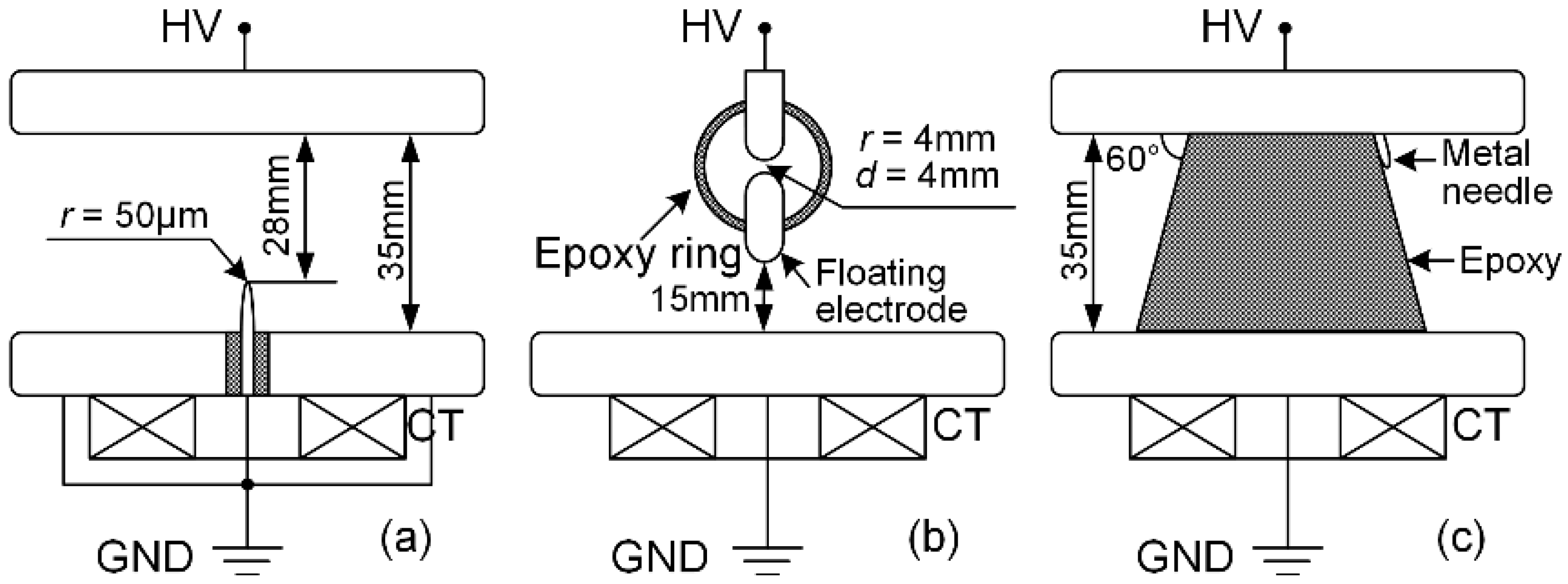
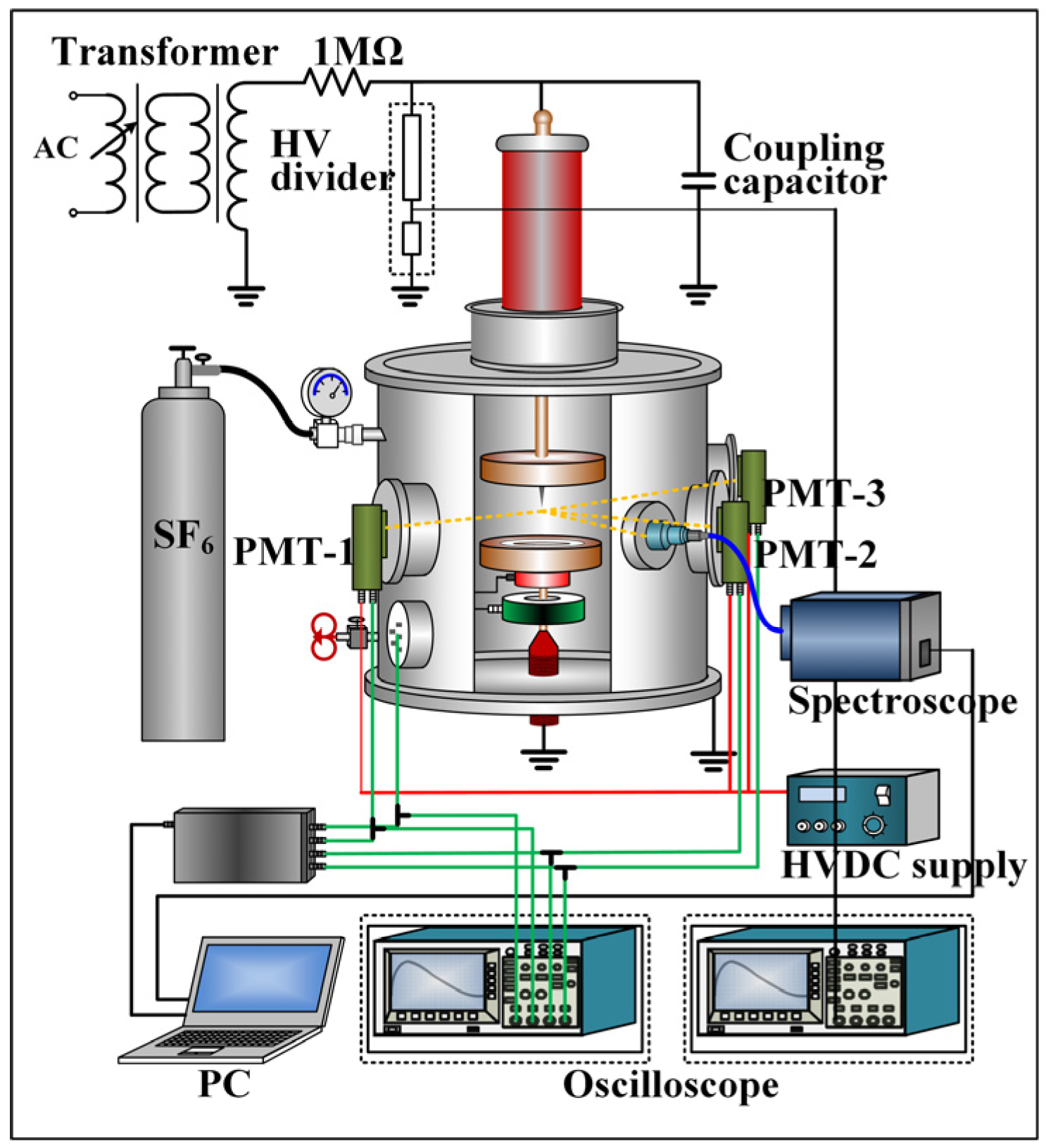

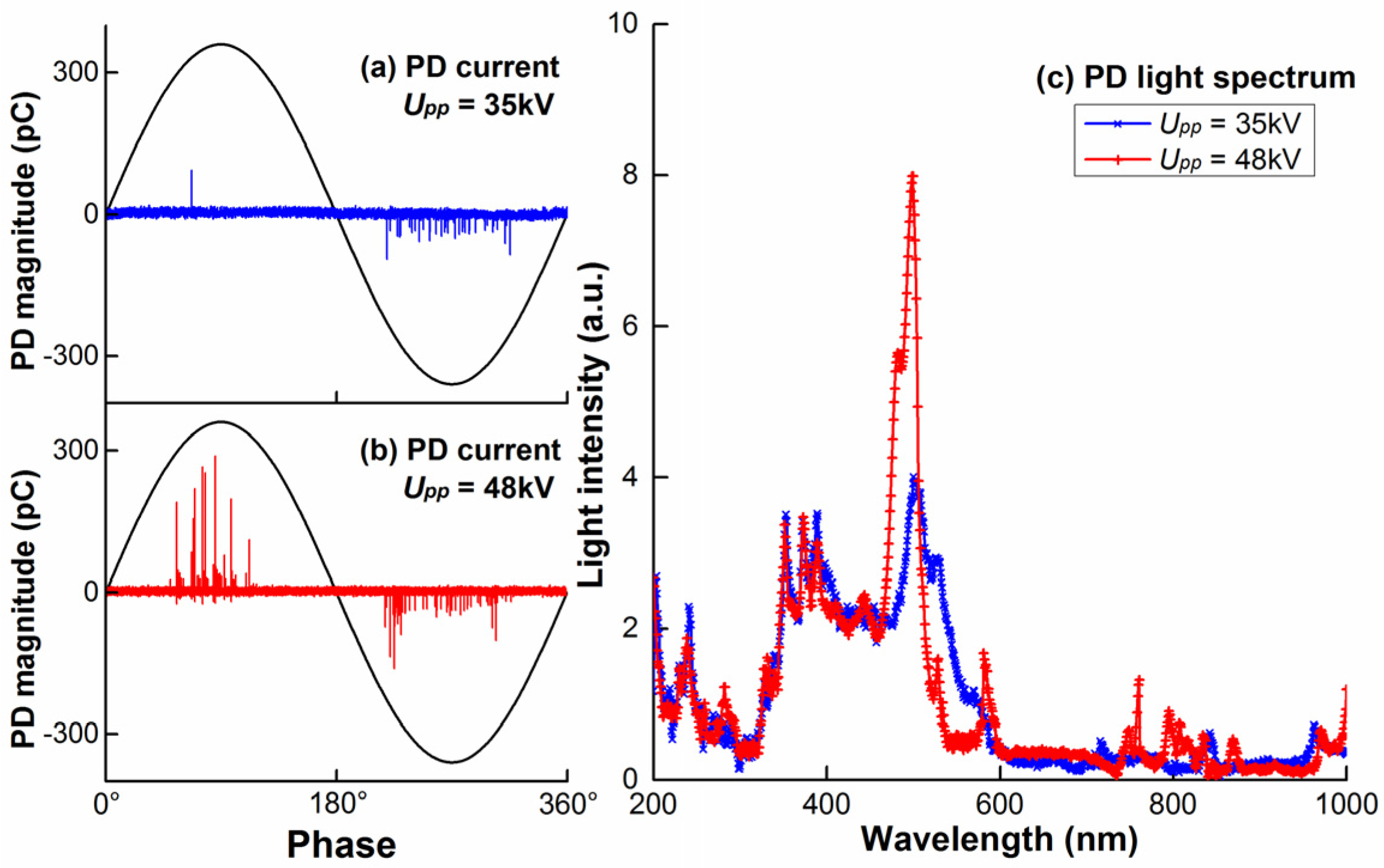

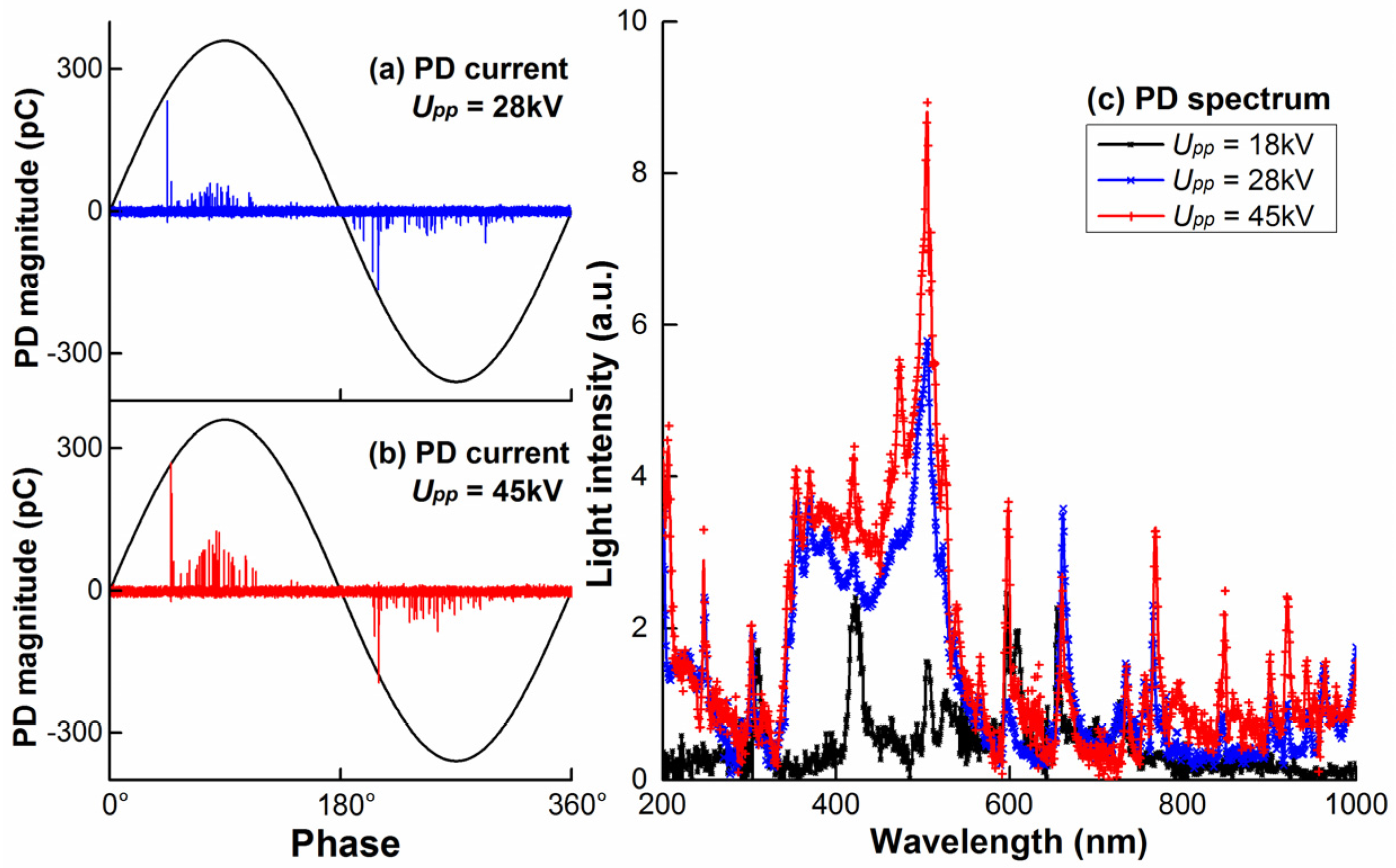



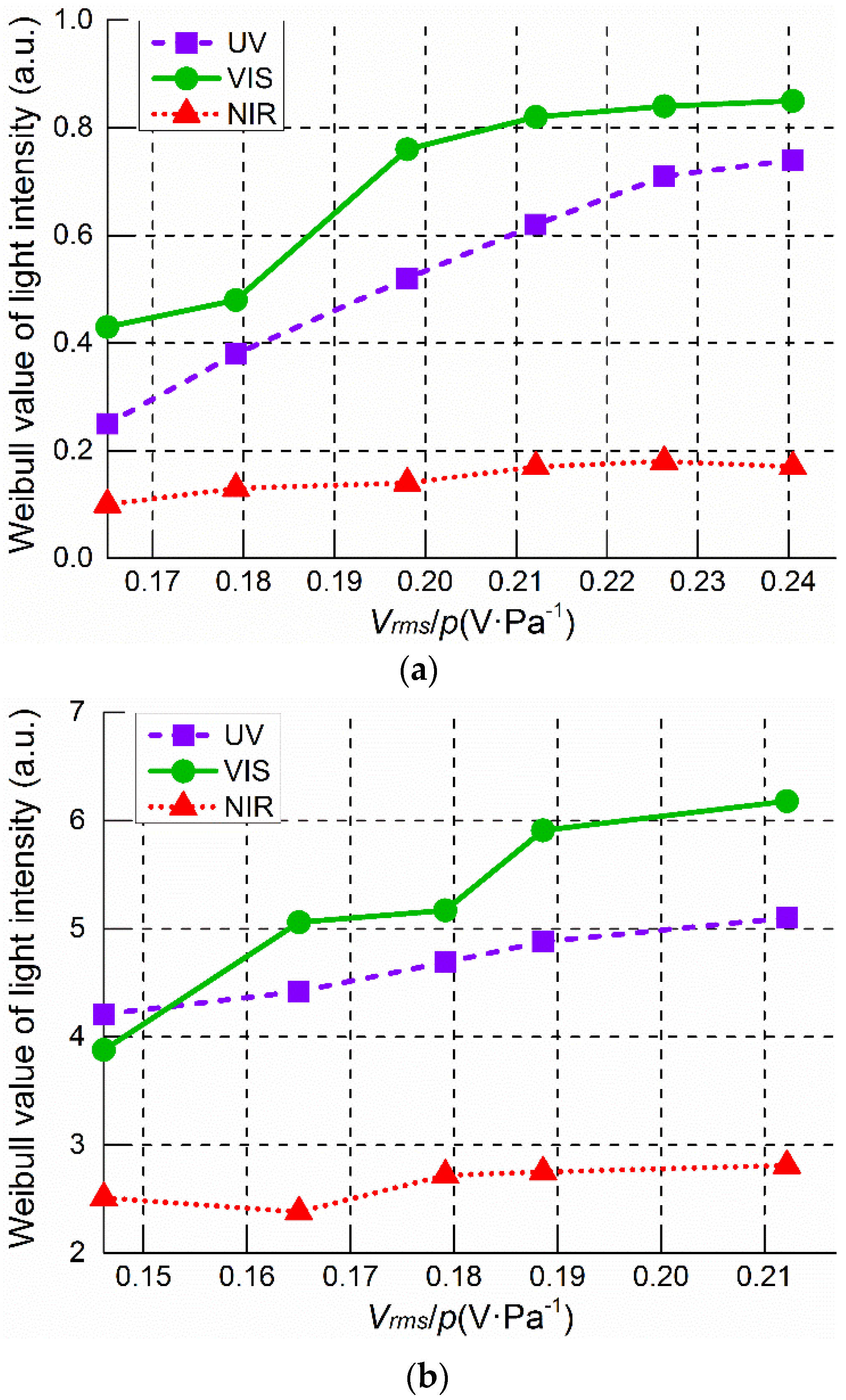
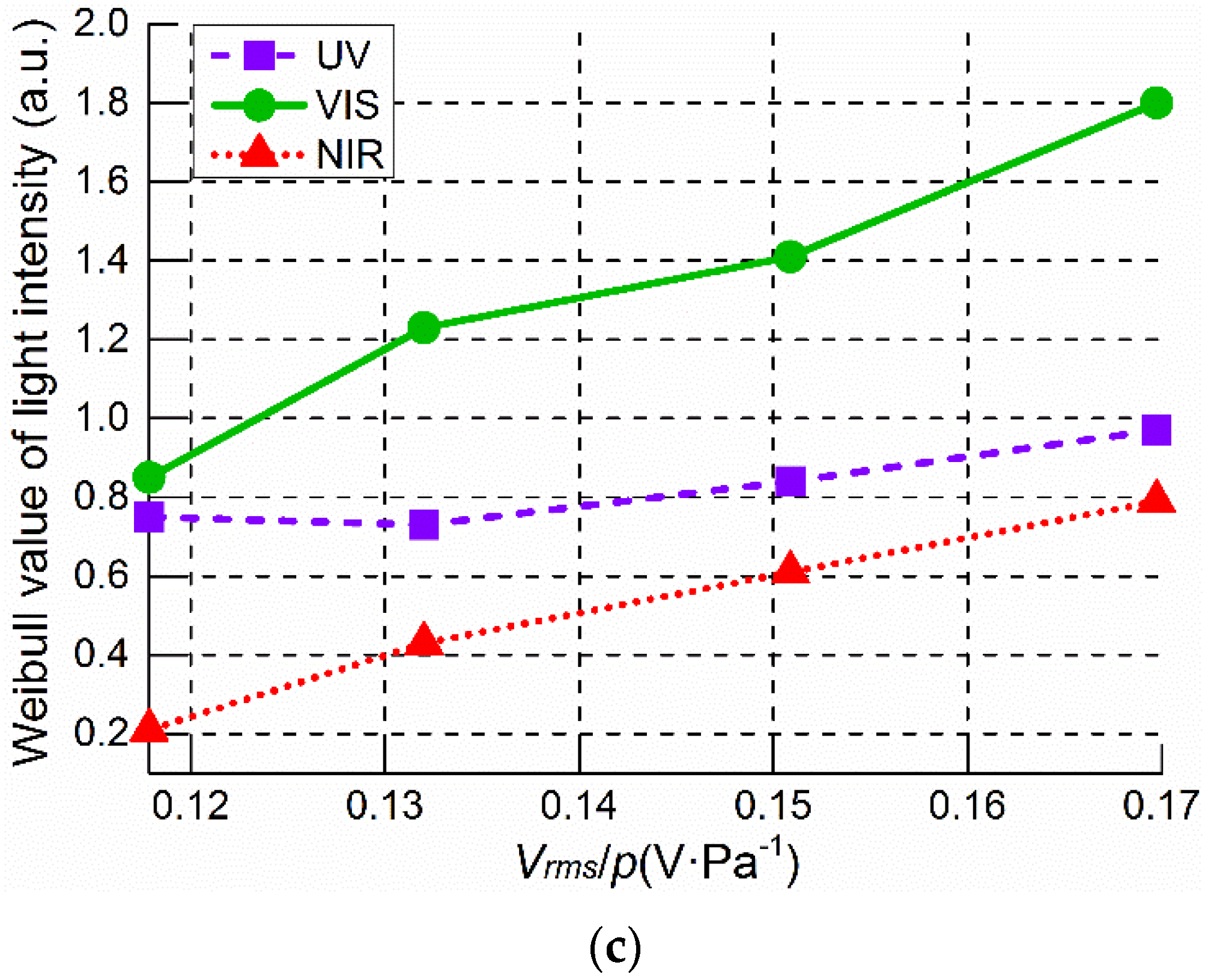

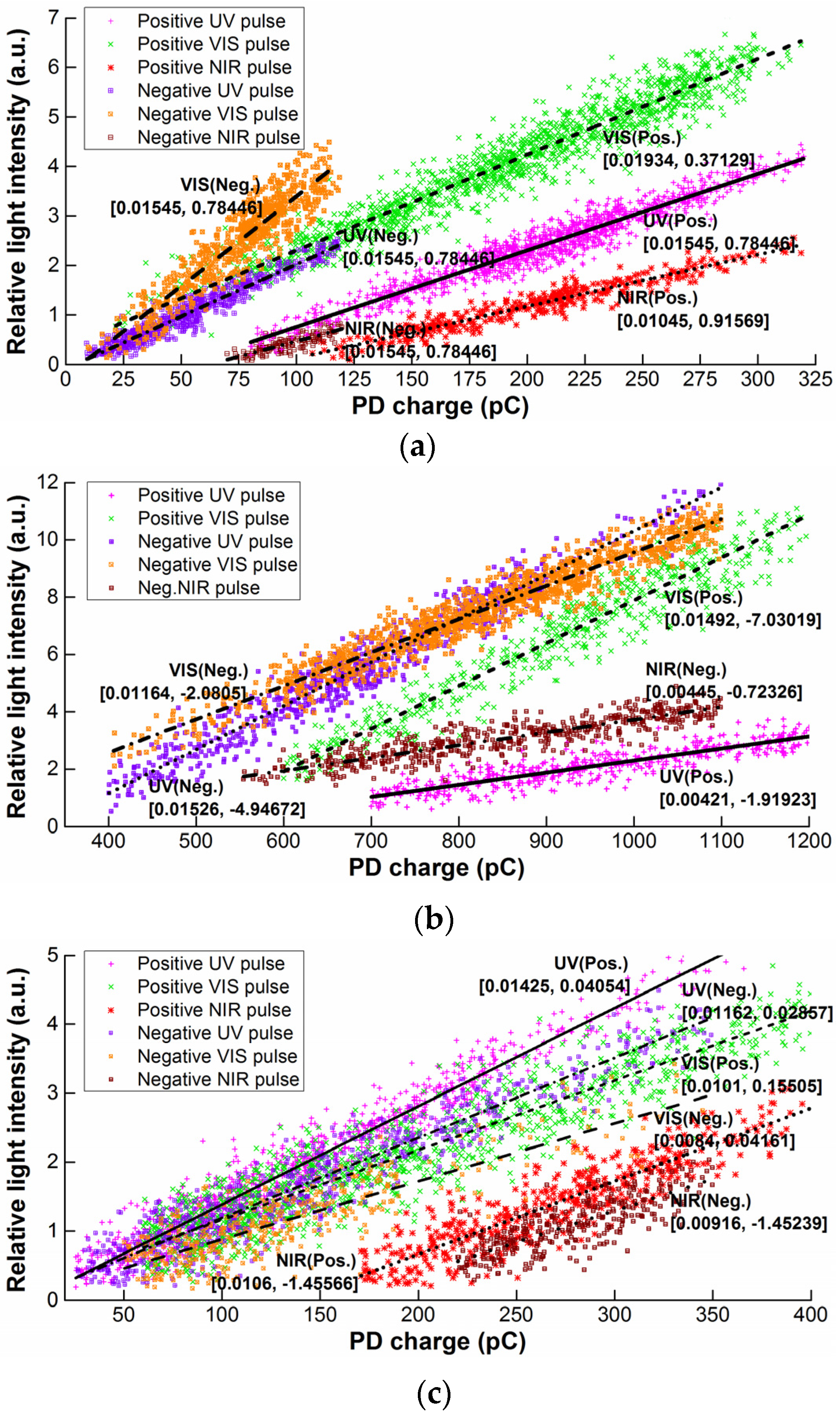
| Parameters | UV Range | VIS Range | NIR Range |
|---|---|---|---|
| llower~lupper | 189 nm~354 nm | 381 nm~675 nm | 737 nm~920 nm |
| k | 2.701 | 1.059 | 1.038 |
| Defects | Protrusion | Floating Potential | Surface Defect | ||||
|---|---|---|---|---|---|---|---|
| Parameters | q/l (pC/a.u.) | N/min | q/l (pC/a.u.) | N/min | q/l (pC/a.u.) | N (min−1) | |
| 1.2PDIV | Current | 26.3 | 3852 | 692.5 | 5401 | 59.9 | 4330 |
| UV | 0.52 | 1705 | 4.6 | 1455 | 0.71 | 1743 | |
| VIS | 0.82 | 2312 | 5.22 | 2152 | 1.03 | 3470 | |
| NIR | 0.18 | 903 | 2.13 | 750 | 0.28 | 784 | |
| 1.5PDIV | Current | 31.41 | 7965 | 813.4 | 6222 | 97.2 | 4555 |
| UV | 0.73 | 3761 | 5.13 | 2305 | 0.93 | 3421 | |
| VIS | 0.87 | 3310 | 6.17 | 3951 | 1.79 | 4073 | |
| NIR | 0.29 | 1033 | 2.65 | 1013 | 0.78 | 2344 | |
| Parameters | (×2.71) UV(Pos.) | (×1.07) VIS(Pos.) | (×1.04) NIR(Pos.) | (×2.71) UV(Neg.) | (×1.07) VIS(Neg.) | (×1.04) NIR(Neg.) |
|---|---|---|---|---|---|---|
| Protrusion fixed on conductor | ||||||
| Slope (A) | 0.01545 | 0.01934 | 0.01045 | 0.02107 | 0.03632 | 0.01243 |
| SE of slope | 1.1503 × 10−4 | 1.3928 × 10−4 | 1.5638 × 10−4 | 2.4230 × 10−4 | 6.0850 × 10−4 | 7.1965 × 10−4 |
| Intercept (B) | −0.78446 | 0.37129 | −0.91569 | −0.0826 | −0.23616 | −0.77071 |
| SE of intercept | 0.02437 | 0.02773 | 0.03267 | 0.01471 | 0.04821 | 0.0706 |
| Adj. R2 | 0.92894 | 0.92812 | 0.91717 | 0.92713 | 0.84403 | 0.6619 |
| Floating metal particle | ||||||
| Slope (A) | 0.00421 | 0.01492 | NA | 0.01526 | 0.01164 | 0.00445 |
| SE of slope | 1.0281 × 10−4 | 1.8394 × 10−4 | NA | 1.3002 × 10−4 | 9.2958 × 10−4 | 1.0215 × 10−4 |
| Intercept (B) | −1.91923 | −7.03019 | NA | −4.94672 | −2.0805 | −0.72326 |
| SE of intercept | 0.09865 | 0.17157 | NA | 0.09282 | 0.07782 | 0.08868 |
| Adj. R2 | 0.83807 | 0.81718 | NA | 0.94679 | 0.95039 | 0.77994 |
| Metal particle on insulator surface | ||||||
| Slope (A) | 0.01425 | 0.0101 | 0.0106 | 0.01162 | 0.0084 | 0.00916 |
| SE of slope | 0.980 × 10−4 | 1.0698 × 10−4 | 2.2567 × 10−4 | 1.3625 × 10−4 | 2.4575 × 10−4 | 4.0147 × 10−4 |
| Intercept (B) | −0.04054 | 0.15505 | −1.45566 | 0.02857 | 0.04161 | −1.45239 |
| SE of intercept | 0.01724 | 0.02255 | 0.06269 | 0.02266 | 0.03706 | 0.11251 |
| Adj. R2 | 0.95366 | 0.87394 | 0.82451 | 0.9112 | 0.75336 | 0.62311 |
© 2016 by the authors; licensee MDPI, Basel, Switzerland. This article is an open access article distributed under the terms and conditions of the Creative Commons by Attribution (CC-BY) license (http://creativecommons.org/licenses/by/4.0/).
Share and Cite
Ren, M.; Dong, M.; Liu, J. Statistical Analysis of Partial Discharges in SF6 Gas via Optical Detection in Various Spectral Ranges. Energies 2016, 9, 152. https://doi.org/10.3390/en9030152
Ren M, Dong M, Liu J. Statistical Analysis of Partial Discharges in SF6 Gas via Optical Detection in Various Spectral Ranges. Energies. 2016; 9(3):152. https://doi.org/10.3390/en9030152
Chicago/Turabian StyleRen, Ming, Ming Dong, and Jialin Liu. 2016. "Statistical Analysis of Partial Discharges in SF6 Gas via Optical Detection in Various Spectral Ranges" Energies 9, no. 3: 152. https://doi.org/10.3390/en9030152





